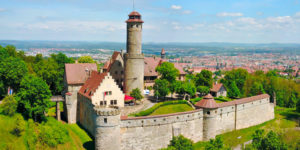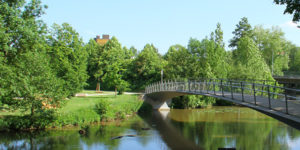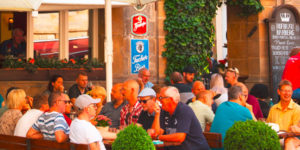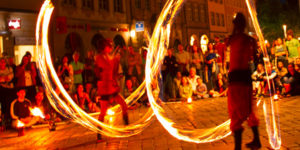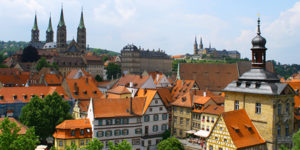The perfect location
In the middle of the 19th century, the tip of the island did not yet belong to the city of Bamberg, but to the neighbouring municipality of Gaustadt. In contrast to the Bamberg city council, Gaustadt was open to the settlement of such an industrial plant. This also explains the choice of this special location. Due to constant expansion, in the course of industrialization Bamberg and Gaustadt grew together and form a unit today.
The first source of energy was to be the water power of the both Regnitz branches, which converged at this point. In this way, the initial 52,000 spindles and 750 looms were to be driven. However, the use of hydropower turned out to be too unreliable due to varying water levels. For this reason, it was decided as early as 1861 to purchase a steam engine to prevent future operational disruptions. In 1963 the first industrial dyeing plant in Bamberg was founded. This was the birth of the Bamberg textile industry of the 19th and 20th centuries.
Expansion of the factory
As is customary with such industrial complexes, the original factory buildings were supplemented with numerous other buildings over time. These were either extensions of the factory itself or measures to connect the local workforce. In the case of the spinning and weaving mill, examples include the “Luther Building” for Protestant families at the foot of the Abtsberg, built in 1883, the iconic water tower from 1897 or the gymnasium on the Ochsenanger, built in 1925. Thus the settlement of the industrial plant had a clear effect on the development of Gaustadt and ultimately Bamberg.
In 1927, the Mechanische Baumwoll-Spinnerei und Weberei Bamberg merged with the Erlangener Baumwollspinnerei AG. The new company became known above all under the abbreviation ERBA and not only supplied the prominent lettering on the water tower in Bamberg, but also the present name of the northern tip of Bamberg island.
During the time of National Socialism, the early Federal Republic of Germany and the guest worker period, ERBA established itself as an important employer in the regions around Bamberg and Erlangen. But the 80s heralded an economically difficult time for the Franconian textile industry. This crisis finally led to the insolvency and closure of the traditional company in 1993.
Landesgartenschau 2012
It was not until the State Garden Show in 2012 that the Bamberg ERBA was brought back to life. After the State Garden Show was over, extensive construction measures followed, during which the former industrial area was converted into necessary living space on one side. On the other hand, a new location was also created for the steadily growing Otto Friedrich University of Bamberg.The ERBA housing project has not yet led to any noticeable relief of the Bamberg housing market, which has caused a lot of annoyance for many Bamberg residents. This is sometimes due to the fact that the private property developer has predominantly built high-priced freehold flats.
A place for families and activities
All that remained of the Landesgartenschau itself was a small park with an idyllic water playground, which can still be seen. Here, on sunny days, students and families with children meet and enjoy the green spot in the middle of the urban hustle and bustle.

